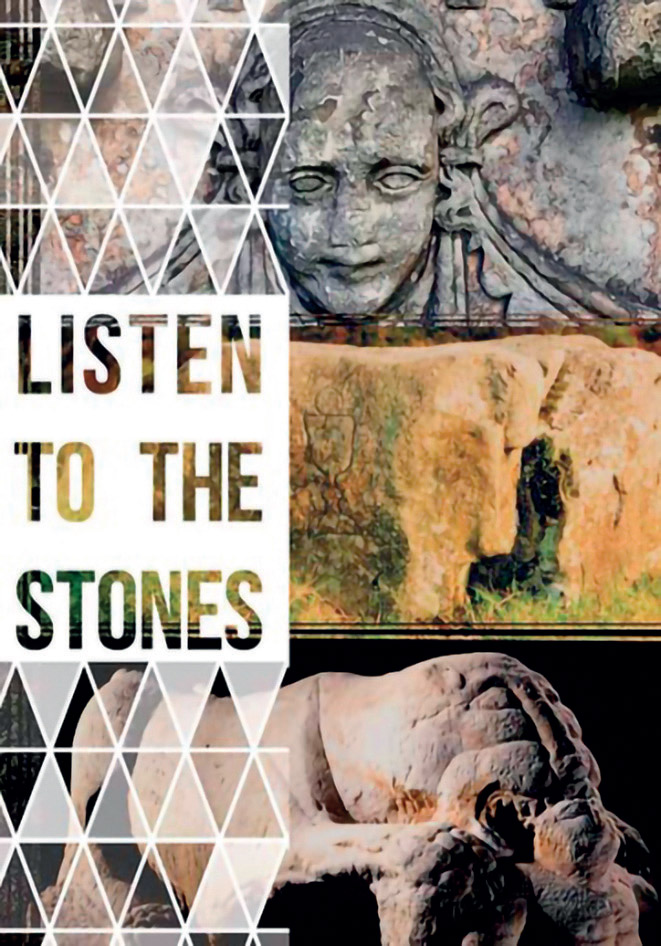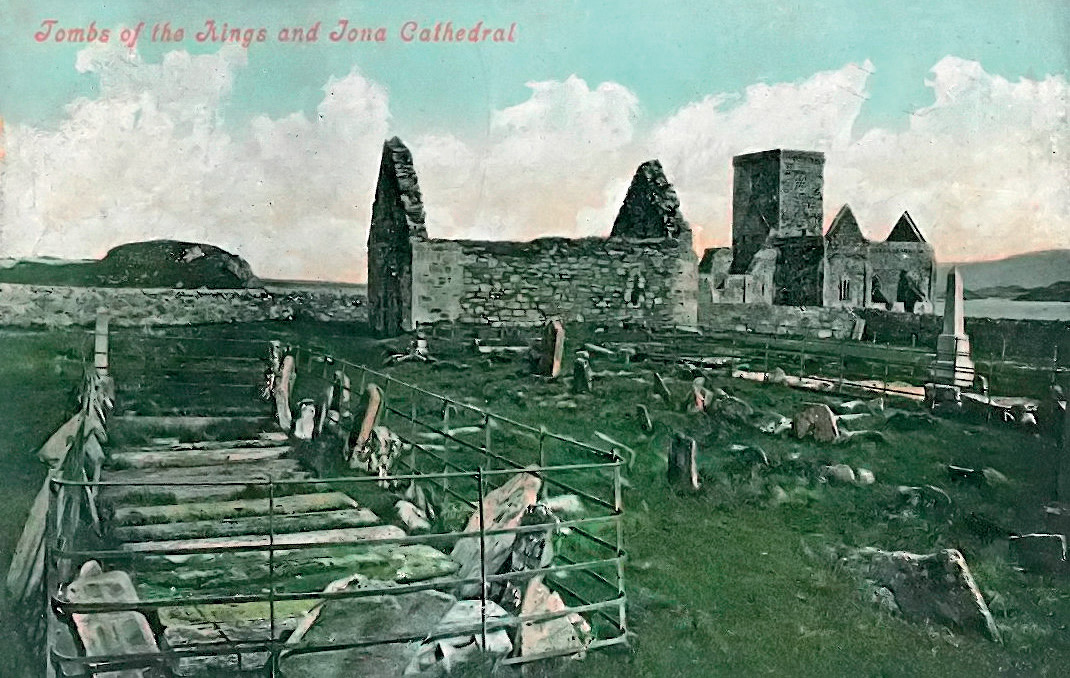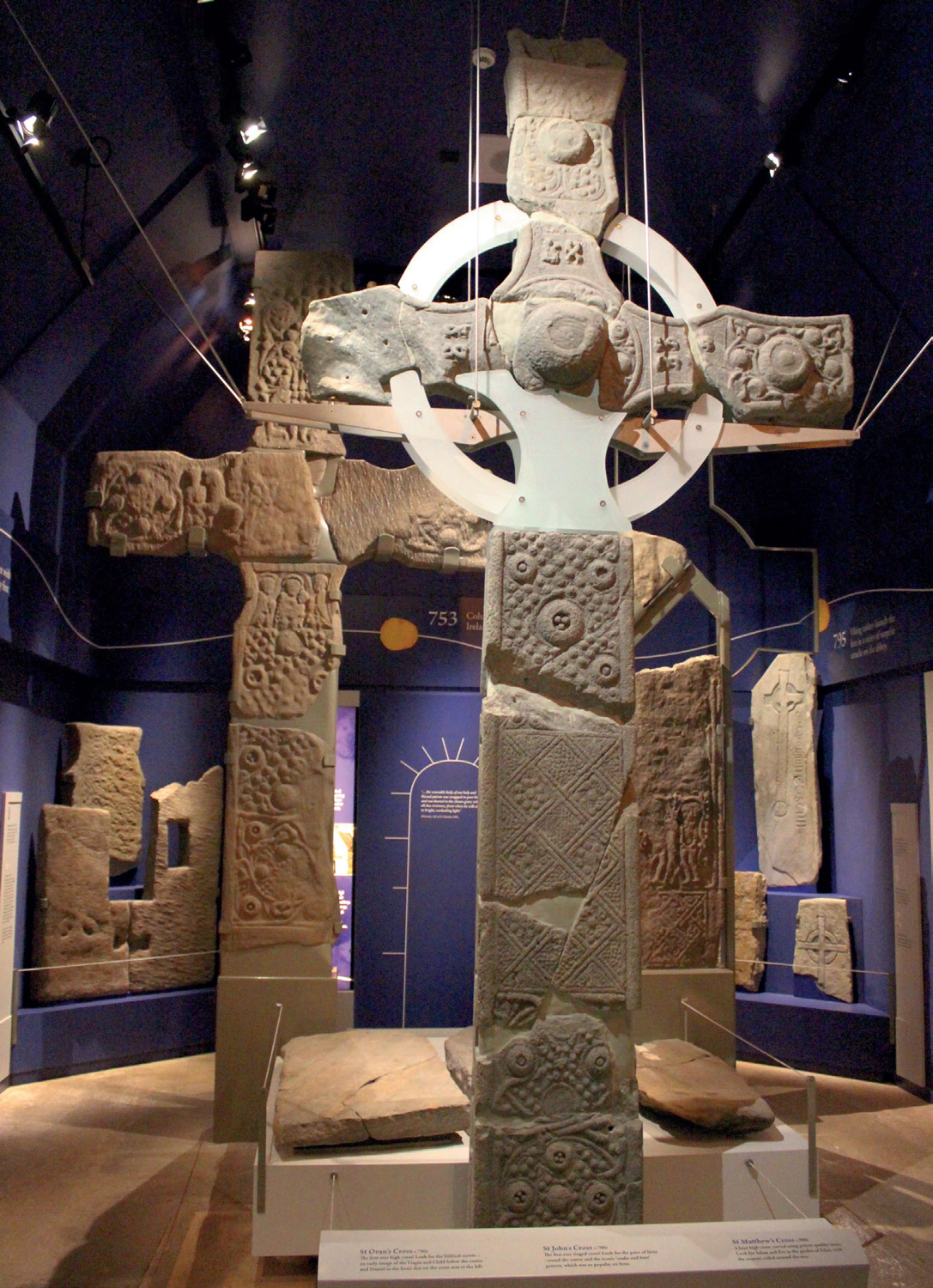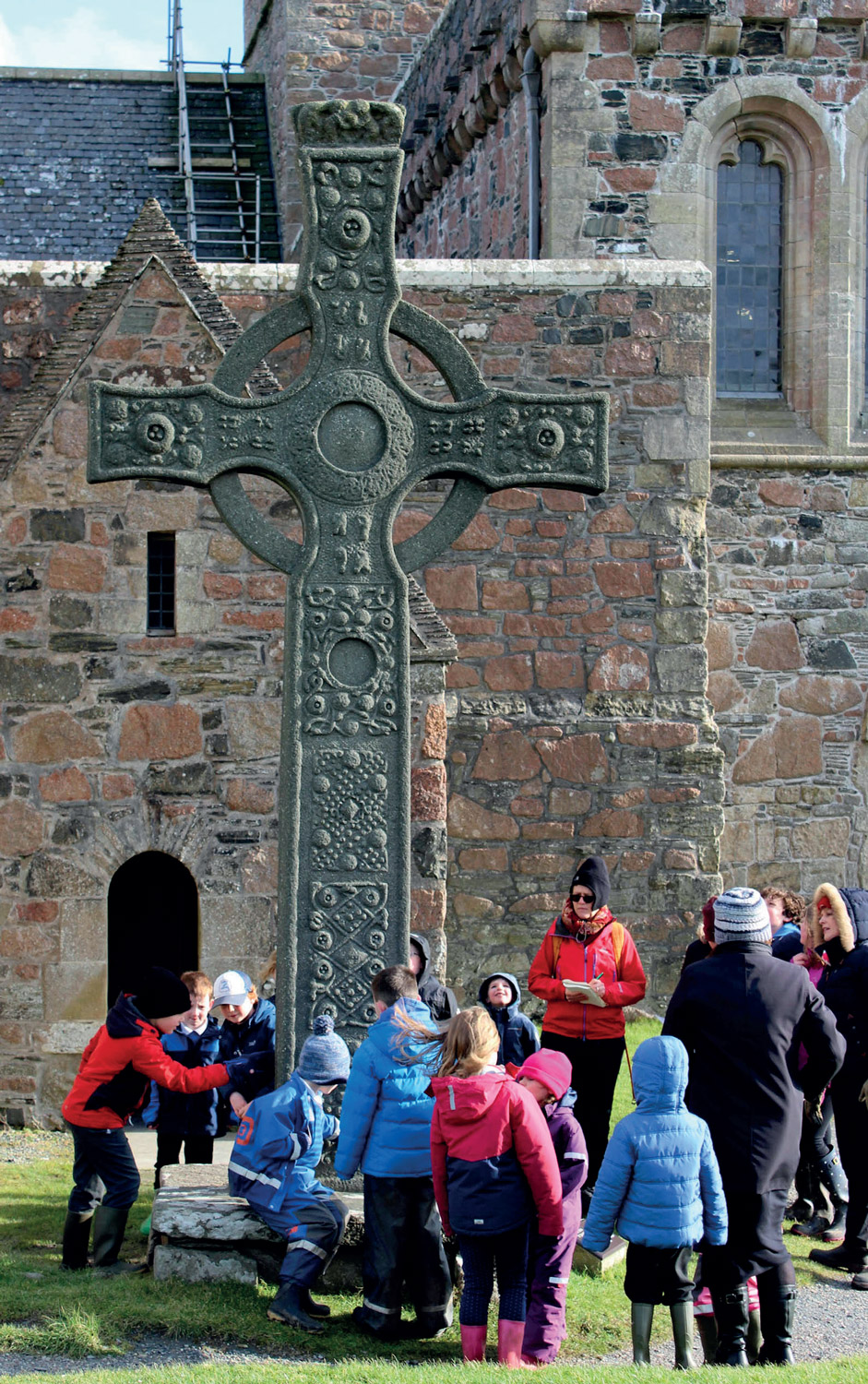Carved Stones
Perspectives from Iona Abbey on Values and Significance
Sally Foster

Located on the island of Iona off the west coast of Scotland and founded as a monastic community by St Columba, Iona Abbey is one of Western Europe’s earliest Christian centres. (Photo: Sally Foster)
ON THE island of Iona, just off the west coast of Scotland, a Benedictine abbey is home to 111 early medieval and 122 late medieval carved stones, and 435 pieces of ex-situ architectural sculpture. After Clonmacnoise, it is the largest and most important collection of early medieval sculpture in Britain and Ireland. Described in 1965 by W Douglas Simpson as ‘priceless monuments’, today this collection is dispersed because of historical and contemporary curatorial challenges.
Historic Environment Scotland’s highly acclaimed site museum, tucked away at the back of the abbey complex, displays the highlights of the carved stone collection. Those deemed of lesser importance can be found either in their original locations or dispersed throughout the abbey buildings and the island. While many are fixed to walls in the abbey church and its cloisters and inside St Oran’s Chapel, others are stored out of site high up in the rafters of the church. Several of the high crosses and/ or their bases remain in situ outside the west end of the abbey, and there are some individual cross-bases in situ on the island. What were deemed the less significant later medieval monuments were left in the islander’s graveyard at Reilig Odhráin. Most other portable carved stone monuments are in storage, in St Ronan’s Church, or in the Fionnphort Centre just across the water on Mull. There is also the occasional example still in private ownership or in the National Museum of Scotland. This arrangement may not yet be the ideal, but the care and promotion of this embarrassment of riches has tested the Iona Cathedral Trust, Iona Community, Historic Environment Scotland and its predecessor bodies, and other national bodies for over a century. However, events since 2012 show what can be achieved with an investment of will, new thinking, effort and resources.
The ‘average’ historic church will not be presented with Iona’s scale of challenge and opportunities, but there are universal and contemporary lessons to be derived from its example if the potential of carved stones associated with historic church sites is to be more widely realised. Beyond the starting point of researching and understanding the nature and significance of the resource itself, these relate to understanding how the resource is valued by the various communities associated with a place, including both tangible and intangible values, contemporaneously and historically. That these values may differ and sometimes even cause conflict is actually a fascinating aspect of carved stones’ rich story-telling potential, as well as knowledge needed to inform contemporary place management. Carved stones can play an extremely important role in contemporary placemaking and defining identities. They can do this in certain contexts because they do not represent ‘themselves’ but symbolise the concerns of individuals and communities in a metaphorical way.
EARLY VALUES: FIRST APPRECIATION OF IONA’S CHURCH RUINS
From the late 17th century onwards Iona, along with neighbouring Staffa, became a highly desirable place for the intrepid early traveller and a new breed of antiquarian to visit. As the aesthetic and antiquarian qualities of Iona’s ruins and associated carved stones came to be appreciated, concerns were expressed about crumbling buildings, dung and weed-covered ground obscuring interiors and sculptured monuments, appropriation of carved stones by islanders for their gravestones, badly behaved tourists and damage caused by antiquarians disturbing the ground they searched.
By 1899, when the Iona Cathedral Trust was created and acquired ownership of the abbey from the Duke of Argyll, there was therefore already a long history of concern about the condition of the ruins and the carved stones. As a future for the abbey was still being forged, debate continued about how the island’s carved stones were to be treated, and who should, or was prepared to, take the lead in caring for them. Different communities had different views and then, as is still often the case, stewardship of the carved stones also fell between cracks: as artefacts/monuments that often move these are, technically, portable. This is a longstanding curatorial and legal issue. Reflecting back in 1973, a civil servant observed that ‘since before the [Second World] War Iona has been a thorn in the flesh of the Ancient Monuments Board and the Ancient Monuments Branch and until fairly recently no board meeting was complete without a discussion on some aspect of Iona’. Getting agreement about what should be done, who should do it and who should pay for works to Iona’s abbey and related monuments bedevilled its history, stretching the patience, tolerance and trust of all parties. There was early and general agreement on the need for a proper lapidarium, a museum to display the stones. However, identifying a place for this was never going to be straightforward and that debate rolled on and on, complicated by sometimes irritable discussions about other issues.
The nature and tempo of events had changed from 1938 when the Iona Community established itself on the island and began to rebuild the abbey. Led by George MacLeod – described by Alexander McCall Smith as ‘one of Scotland’s most charismatic and influential figures of the 20th century’ – the mission for this Christian ecumenical community was to establish a socially relevant church. MacLeod’s attitude to Iona’s carved stones is fascinating as a well-documented historical example that exposes the starkly different values of different communities of interest.
CONFLICTING VALUES: ‘HISTORY VERSUS MYSTERY; SCIENCE AND ART VERSUS FAITH’
MacLeod’s burgeoning Iona Community needed space to live and work. While its earliest stated plans incorporated converting the ruined Infirmary building into a museum for carved stones, this was because they wanted the stones out to give the visitor an impression that it is an antiquarian show place. If the abbey is to be the home of a living and vital community this is an impression which we wish to avoid at all cost’, noted the Community’s architect, Ian Lindsay. For MacLeod, for all that Iona was a ‘unique treasure of our Christian heritage’, and that its carved stones might be ‘lovely’, the emphasis was on restoration to create a living place. For MacLeod, there was also no difference between secular and sacred, and to be a living place meant that stone sculpture designed to be outside should remain there: ‘I belong to the other school which is horrified at gathering into museums, however hygienic, the living symbols of the Faith’; ‘the stones might well be allowed to decay in the open in God’s own time’. As far as MacLeod was concerned, the Ancient Monuments Board for Scotland was obsessed with dead things, summarising the argument as ‘History versus Mystery; Science and Art versus Faith’.
MacLeod’s construction of a new identity for Iona Abbey as a place that was once again mainstream in Christian life was therefore at odds with those who placed an emphasis on its cultural significance as national patrimony and a place of international archaeological, historical and art-historical significance. For these people, the prime objective in this context was preservation of the material fabric of the monuments. This included the invisible archaeological evidence for the Columban and later monastery. The aim was not just to protect a significant artistic and ancient resource for the benefit of scholars, but also for Iona’s tourists and pilgrims.
CHANGING ATTITUDES TO WHAT IS VALUED AND WHY
The need to resolve the fate of Iona’s carved stones was given new impetus in 1957 when the internationally significant 8th-century St John’s Cross fell disastrously, for at least the fourth time in its life. However, finding a home for the cross and Iona’s other carved stones, either inside or beyond the abbey, was extremely difficult. After extended discussion with George MacLeod and debates at national level, a small museum was finally built in 1964, although it was not until 1990 that the St John’s Cross was re-erected there, by when it had been identified by the RCAHMS as the world’s first ‘Celtic cross’.
Meantime, individuals who loved Iona were upset about the loss of the Cross from its position in front of the shrine-chapel built over St Columba’s burial. To cut a long story short, their determined and extended efforts liaising with numerous parties led to the erection of a concrete replica on 6 June 1970. Ethnographic work on Iona, undertaken by the author with Siân Jones, illuminates how a replica such as this can acquire forms of authenticity and value, informed by social relations, craft practices, creativity, place and materiality. This research challenges traditional precepts that seek authenticity in qualities intrinsic to original historic objects. It argues that replicas are important objects in their own right, with their own creative human stories – biographies that people can connect with.
Given these findings, it was interesting that a 2015/16 review of the listing and scheduling of Iona Abbey had not included the St John’s Cross replica. Of all the things that were technically eligible for designation it was not overlooked, it was specifically excluded. In March 2020 however, informed by our research, the replica was Category A listed (see http://bc-url.com/LB52541). Still, legal designation is only one way of marking esteem or caring for things and, because of its history, designation practices do still struggle to recognise and apply the rich and diverse forms of authenticity and social/spiritual value that our research reveals. That said, recent developments, in Scotland at least, mean that designation is placing more emphasis on social history. On-site interpretation has more potential scope to embrace actual and ‘felt’ relationships with people, places and things. Forthcoming interpretation at Iona Abbey will now recognise that the replica is more than a proxy for the original as well as alluding to aspects of its social history.
LISTEN TO THE STONES
 |
||
| Cover of Listen to the Stones, a downloadable leaflet outlining alternative ways of looking at carved stones and their replicas. (Design: www.carmenland.com) |
Both these example hint at ways in which revealing the social/spiritual values of carved stones and their replicas adds ‘colour’ that can illuminate and enhance the history of ancient churches as well as their experience by contemporary communities. The interdisciplinary study of Iona recently published as My Life as a Replica: St John’s Cross, Iona, illustrates the value of new thinking about replicas. This detailed study practices alternative ways of looking at carved stones and their replicas as advocated in Future Thinking about Carved Stones on Scotland: A Research Framework. Structured around the heritage cycle, these online principles and guidance are widely applicable to carved stones anywhere and of any period. Issues specific to carved stones at churches are recognised, and historic churches feature in many of the accompanying case studies. The resource can be downloaded as a PDF and a shorter, more accessible version is available, Listen to the Stones.
Too often though, the early medieval horizon of a historic church is unrecognised or underplayed in the care and promotion of a church. The ECCLES project (Early Christian Churches and Landscapes) led by Thomas Pickles at Chester University aims to create a web portal that will bring together the textual, material and onomastic evidence for Ireland and Britain’s churches pre-dating 1100. In so many places, carved stones will inevitably be brought to the fore.
Key to the re-evaluation of the replica at Iona Abbey has been fresh research. Historically focused research was core to the development of Historic Environment Scotland’s reinterpretation of the Columban monastery, not least its 2013 redisplay of carved stones in the site museum. When contemporary and temporal social and spiritual values are explored and added to the mix, further new perspectives become a possibility, gravitating around the story-telling potential of the lives of carved stones and their replicas.
Further Reading
Early Christian Churches and Landscapes [ECCLES] https://earlychristianchurchesandlandscapes.wordpress.com
Future Thinking on Carved Stones in Scotland: A Research Framework https://scarf.scot/thematic/future-thinking-on-carved-stones-in-scotland
New Futures for Replicas in Heritage and Museums: Principles and Guidance for Museums and Heritage www.replicas.stir.ac.uk
Designation of St John’s Cross, Iona, March 2020 http://bc-url.com/LB52541.
S Foster & S Jones ‘The untold heritage value and significance of replicas’, Conservation and Management of Archaeological Sites, 21(1), 1–24. DOI: 10.1080/13505033.2019.1588008.
S Foster & S Jones My Life as a Replica: St John’s Cross, Iona, London, 2020: www.oxbowbooks.com (for 20% discount apply voucher code REPLICA20)







